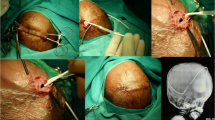Abstract
Introduction
The subgaleal space is the fibroareolar layer found between the galea aponeurotica and the periosteum of the scalp. Due to its elastic and absorptive capabilities, the subgaleal space can be used as a shunt to drain excess cerebrospinal fluid from the ventricles. A subgaleal shunt consists of a shunt tube with one end in the lateral ventricles while the other end is inserted into the subgaleal space of the scalp. This will allow for the collection and absorption of excess cerebrospinal fluid. Indications for ventriculosubgaleal shunting (VSG) include acute head trauma, subdural hematoma, and malignancies.
Discussion
VSG shunt is particularly advantageous for premature infants suffering from post-hemorrhagic hydrocephalus due to their inability to tolerate long-term management such as a ventriculoperitoneal shunt. Complications include infection and shunt blockage. In comparison with other short-term treatments of hydrocephalus, the VSG exhibits significant advantages in the drainage of excess cerebrospinal fluid. VSG shunt is associated with lower infection rates than other external ventricular drain due to the closed system of CSF drainage and lack of external tubes.
Conclusion
This review discusses the advantages and disadvantages of the VSG shunt, as well as our personal experience with the procedure.




Similar content being viewed by others
Change history
25 August 2018
The original version of this article unfortunately contained an error.
References
Aschoff A, Kremer P, Hashemi B, Kunze S (1999) The scientific history of hydrocephalus and its treatment. Neurosurg Rev 22:67–93
Drapkin A, Levine ME, Yang WC (1980) Ventriculo-subgaleal shunt: evaluation by computed tomography. Acta Neurochir 55:107–115
Hansasuta A, Boongird A (2007) Ventriculo-subgaleal shunting: step-by-step technical note. J Med Assoc Thail 90:473–478
Nee LS, Harun R, Sellamuthu P, Idris Z (2017) Comparison between ventriculosubgaleal shunt and extraventricular drainage to treat acute hydrocephalus in adults. Asian J Neurosurg 12:659–663
Reinprecht A, Dietrich W, Berger A, Bavinzski G, Weninger M, Czech T (2001) Posthemorrhagic hydrocephalus in preterm infants: long-term follow-up and shunt-related complications. Childs Nerv Syst 17:663–669
Rizvi SA, Wood M (2010) Ventriculosubgaleal shunting for post-haemorrhagic hydrocephalus in premature neonates. Pediatr Neurosurg 46:335–339. https://doi.org/10.1159/000320135
Savitz MH, Malis LI (2000) Subgaleal shunting: a 20-year experience. Neurosurg Focus 9:1–5. https://doi.org/10.3171/foc.2000.9.6.11
Seery GE (2002) Surgical anatomy of the scalp. Dermatol Surg 28:581–587. https://doi.org/10.1046/j.1524-4725.2002.12015.x
Tubbs RS, Smyth MD, Wellons JC III, Blount JP, Grabb PA, Oakes WJ (2003) Alternative uses for the subgaleal shunt in pediatric neurosurgery. Pediatr Neurosurg 39:22–24. https://doi.org/10.1159/000070875
Tubbs RS, Smyth MD, Wellons JC III, Blount JP, Grabb PA, Oakes WJ (2003) Life expectancy of ventriculosubgaleal shunt revisions. Pediatr Neurosurg 38:244–246. https://doi.org/10.1159/000069827
Tubb RS, Banks JT, Soleau S, Smyth MD, Wellons JC, Blount JP, Grabb PA, Oakes WJ (2004) Complications of ventriculosubgaleal shunts in infants and children. Childs Nerv Syst 21:48–51. https://doi.org/10.1007/s00381-004-0967-6
von Mikulicz J (1896) Beitrage zur Pathologie und Therapie des Hydrocephalus. Mitteil Grenzgeb Med Chir 1:264–301
Wang JY, Amin AG, Jallo GI, Ahn ES (2014) Ventricular reservoir versus ventriculosubgaleal shunt for posthemorrhagic hydrocephalus in preterm infants: infection risks and ventriculoperitoneal shunt rate. J Neurosurg Pediatr 4:447–454. https://doi.org/10.3171/2014.7.peds13552
Willis BK, Kumar CR, Wylen EL, Nanda A (2005) Ventriculosubgaleal shunts for posthemorrhagic hydrocephalus in premature infants. Pediatr Neurosurg 41:178–185. https://doi.org/10.1159/000086558
Author information
Authors and Affiliations
Corresponding author
Ethics declarations
Conflict of interest
The authors declare that they have no conflict of interest.
Rights and permissions
About this article
Cite this article
Eid, S., Iwanaga, J., Oskouian, R.J. et al. Ventriculosubgaleal shunting—a comprehensive review and over two-decade surgical experience. Childs Nerv Syst 34, 1639–1642 (2018). https://doi.org/10.1007/s00381-018-3887-6
Received:
Accepted:
Published:
Issue Date:
DOI: https://doi.org/10.1007/s00381-018-3887-6




